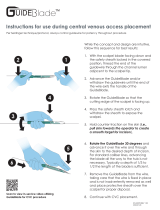
CAUTION: For subclavian/axillary procedures, the distance between the annular plane and the integrated sheath distal tip
must be ≥ 17 cm (6.7") to allow the valve capsule to retract completely during valve deployment.
Predilate the native aortic valve with an appropriate diameter valvuloplasty balloon.
Deploying the Valve
Backload the FlexNav™ delivery system onto an 0.035" (0.89 mm)-compatible manufacturer pre-shaped guidewire while
maintaining position across the aortic valve.
NOTE: Wipe the radiopaque tip, valve capsule, and integrated sheath with a wet gauze pad to activate the hydrophilic coating.
Advance the distal end of the delivery system through the access site until the integrated sheath hub meets the access site. If using
the integrated sheath, be sure to hold on to both the integrated sheath and the delivery system shaft, keeping them joined together
upon insertion.
NOTE: It is recommended to rotate the delivery system and integrated sheath back and forth during insertion into the artery.
Position the delivery system so that the inner shaft marker band is aligned with the native aortic valve annulus plane.
Begin deploying the valve by turning the deployment/re-sheath wheel in the direction of the arrow on the handle. Maintain valve
position during deployment to ensure accuracy of implant depth.
NOTE: Position the leading inflow edge of the valve 3 mm (0.12") below the native aortic annulus.
Prior to release, position the fluoro source to ensure the struts at the ventricular end of the nitinol stent are aligned and confirm the
depth of the implant is approximately 3mm.
NOTE: The deployment/re-sheath wheel will make a clicking sound when it has reached the partial deployment lock, and the
deployment mechanism will not engage until the deployment lock button is depressed.
CAUTION: Do not depress the deployment lock button until you are ready to fully deploy the valve.
If the valve must be re-positioned, proceed to instructions for re-sheathing the valve.
If proper placement is confirmed, complete valve deployment by pressing the deployment lock button, then turning the
deployment/re-sheath wheel in the direction of the arrow on the handle until the valve capsule is fully retracted.
NOTE: The deployment/re-sheath wheel will make a clicking sound when the valve capsule is fully retracted.
Once the valve is fully deployed, confirm (under fluoroscopy, using orthogonal views) that the retainer tabs have detached from the
delivery system retainer receptacle.
Re-Sheathing the Valve (Optional)
If repositioning is required, fully re-sheath the valve by turning the deployment/re-sheath wheel opposite the direction of the arrow on the
handle. Return to step 3 of "Deploying the Valve."
CAUTION: To prevent potential tissue trauma, close any gap between the valve capsule and the radiopaque tip. If necessary,
turn the micro adjustment wheel in the direction of the arrow to close gaps between the valve capsule and the radiopaque tip.
Once the gap is closed, turn the micro adjustment wheel opposite the direction of the arrow until the wheel stops.
CAUTION: Do not re-sheath the valve more than two times. If additional positioning attempts are needed, completely re-sheath
the valve and remove the valve from the patient. Use a new valve and delivery system to complete the procedure.
Post-Deployment
While maintaining the guidewire position, close the delivery system following the instructions below.
CAUTION: Use care to minimize contact between the valve and the radiopaque tip of the delivery system.
a. For transfemoral procedures, withdraw the radiopaque tip of the open delivery system through the valve, into the
descending aorta. Depress the macro slide buttons and pull back on the proximal end of the handle to close the system.
Withdraw the delivery system until the valve capsule reaches the integrated sheath.
b. For subclavian/axillary procedures with a separate introducer sheath, begin to withdraw the open delivery system into the
introducer. Stop when the radiopaque valve capsule marker band is aligned with the radiopaque band on the introducer.
Maintaining the alignment of the introducer and the valve capsule, depress the macro slide buttons and pull back on the
proximal end of the handle to close the system.
c. For subclavian/axillary procedures using the integrated sheath, withdraw the radiopaque tip of the open delivery system
through the valve until the valve capsule reaches the integrated sheath. Depress the macro slide buttons and pull back on
the proximal end of the handle to close the system.
NOTE: Confirm that the proximal end of the handle is fully retracted before withdrawing the delivery system.
Remove the delivery system and leave the guidewire in the vasculature.
NOTE: Keep integrated sheath and valve capsule together when withdrawing the delivery system.
Use fluoroscopy to ensure full expansion of the nitinol valve stent. Perform an aortogram to assess the degree of PVL, coronary
patency, and valve position. Assess Hemodynamic function by echo and/or pressure recordings. Greater than MILD PVL should be
addressed, during the index procedure, if present.
Close the access site according to standard practice.
NOTE: Patient monitoring for conduction disturbances is recommended.


























